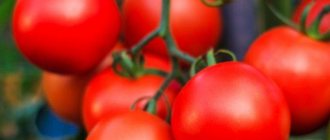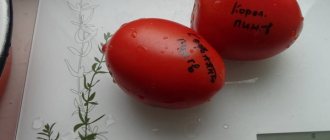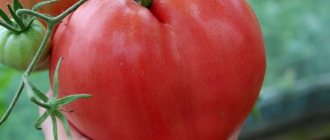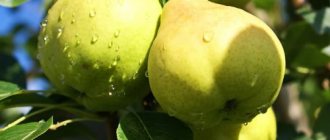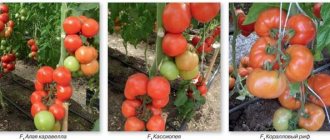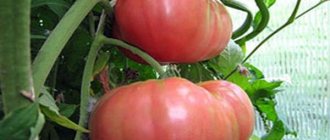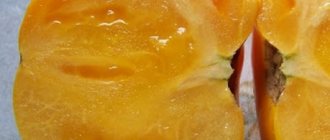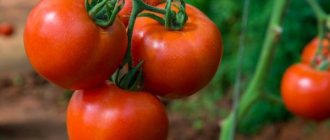Sweet, beautiful tomatoes, reminiscent of an exotic fruit in color and cut, have joined the ranks of unusual varieties. The Kiwi tomato is not inferior in value and abundance to the Malachite Box and Emerald. It has an unusual aroma with pleasant fruity notes.
| Height | Landing location | Ripening time | Fruit color | Fruit size | Origin | Fruit shape |
| Medium height | Greenhouse, Open ground | Mid-season | Greens | Large | Variety | Flat-round |
Description and characteristics of the variety
Kiwi attracts attention not only with its excellent taste and productivity, but also because it is easy to care for the variety. Tomatoes are actively cultivated in greenhouse conditions, greenhouse structures, and open areas. Ripening takes place in the middle period, lasting until autumn frosts.
The collection of the first fruits begins 114-118 days after germination.
Characteristics and features of the variety:
- medium-sized, semi-spreading bushes;
- stem height up to 1.5 m (in greenhouse beds);
- shoot height 0.8-0.9 m (open air);
- semi-determinant growth;
- moderate foliage.
Green tomatoes are good in fresh salads, slices, appetizers, and as an addition to hot side dishes. Used for canning in slices and collecting juice.
What is the attractiveness, description of the fruit:
- weight 200-300 g;
- maximum weight up to 500-600 g;
- emerald coloring;
- the pulp is sweet, moderately juicy;
- taste with fruity notes;
- flattened shape;
- at maturity the flesh is marsh-yellowish;
- The skin is strong and does not crack.
Growing and care
Successful cultivation is possible even in conditions of changeable climate and cool summers. The main requirement is compliance with the basic recommendations of leading agricultural technicians.
Deadlines
Like many other tomatoes, Kiwi is grown by sowing seedlings. It is natural that depending on the climate and location of the region, these periods will change in each individual case. For example, in most regions, sowing for seedlings is carried out in early to mid-March; in particular, for certain areas, March 1-10 is considered the optimal time.
Capacity
Depending on the available capabilities, resources and personal preferences of each gardener, different forms and containers are used for seedlings, both factory-made and those made independently from scrap materials. Most often used:
- boxes made of plastic, wood;
- food packaging;
- disposable plastic cups;
- purchased ready-made forms of various types;
- cassettes with individual cells;
- peat tablets and forms.
The optimal size of such a pot is 10*10 cm.
Regardless of the container chosen, there must be drainage holes at the bottom to prevent rotting of the root system of the sprout.
Related article:
How to speed up the ripening of tomatoes
Planting material
Agronomists and agricultural technology specialists recommend purchasing seeds from trusted manufacturers. Such planting material will ensure high germination and guarantee a good harvest in the future.
At the same time, experienced gardeners are engaged in independent selection of seeds from fruits grown in their summer cottages for subsequent sowing.
Immediately before sowing, it is necessary to prepare the planting material:
- Pour the seeds onto gauze folded in several layers.
- Wrap and place in a bowl.
- Fill with an activator-growth regulator (for example, “Agat”, “Epin”) - apply according to the instructions for use.
- Leave for 10 hours.
- Remove and place to dry on a sheet of paper towel.
For successful germination, it is necessary to maintain the air temperature in the room with trays within +20-25 degrees Celsius.
Priming
For individual forms, you can use ready-made purchased substrates; consultants in gardening stores will help you choose the right option based on the requirements of the variety. Also, many summer residents practice preparing their own soil mixture, for which it is necessary to take the following ingredients in equal parts:
- peat;
- river sand;
- turf land.
First, sift each of the components, remove weeds, roots and debris. Mix in a deep container and leave for a while.
For an open garden bed, it is recommended to choose a well-lit area of the garden without the shadow of fences and tall trees. Before sowing, dig up with fertilizer, wood ash, compost and manure. It is not advisable to use last year's planting sites where potatoes, eggplants, peppers, physalis or onions were previously grown, since such soil has a high risk of containing late blight.
Related article:
Recipes for feeding tomatoes growing in open ground
The optimal predecessor crops are root vegetables, legumes and pumpkins.
Plan ahead: What crops can coexist in the garden
Preference is loamy soil with the mandatory application of organic fertilizers.
Sowing
The main recommendations for carrying out the work are as follows:
- General boxes or containers. Fill the bottom with drainage, then soil, level it, loosen it and pour water on it. Leave until all the liquid is absorbed. Make grooves on the surface at a distance of 3 cm from each other.
Using tweezers or a stick, carefully spread the seeds to a depth of 1 cm, keeping a distance of 2-3 cm. Sprinkle earth on top (1.0-1.5 cm).
- Individual forms. Fill with drainage and substrate, water, leave for half an hour. Place 2-3 seeds in each mold and sprinkle a little.
Spray warm water with a spray bottle. Cover with film or glass and place in a warm place. Initially, you cannot use window sills, since direct sunlight will cause the hatching seed embryos under the film to die.
Before planting in a permanent bed, seedlings grow in forms for 55-60 days.
Country tricks: Planting tomato seedlings in a snail
Picking
Seedlings sown in boxes require picking - transplanting into larger individual forms. Carrying out this process carefully is extremely important for the subsequent growth and development of the plant.
The optimal time for such manipulation is the beginning of the formation of the second true leaf after the existing first one (excluding cotyledons). The sprout reaches this state 10-15 days after emergence, however, this feature is quite individual depending on the growing conditions.
Related article:
Tomato Rio Grande - description and characteristics of a super-yielding variety
The recommended temperature is +18-20 degrees Celsius.
To promote the full development of sprouts in the evening and at night, additional illumination with fluorescent lamps is necessary.
Seedlings, initially planted in forms, upon reaching the recommended period, namely the second ten days of May, are planted immediately on the prepared bed without diving.
Landing in a permanent place
The previously allocated space or soil in the greenhouse must be prepared; planting is carried out in holes according to the 50*50 cm pattern.
Some gardeners practice planting seedlings 2 bushes in each hole. At the same time, it is important to observe the permissible number of plants that will grow per 1 square meter. m - there should be no more than 3 pieces.
If tomatoes are planted in open soil earlier, for example, in early May, then in their reviews gardeners talk about the need for additional covering with film or spunbond. It is removed when the weather has been persistently warm for several days.
Fruit ovary occurs at an average air temperature of +17 degrees Celsius.
Watering
The vegetable is a drought-resistant crop; excessive soil moisture leads to the death of the plant. Therefore, during the growing season, watering is carried out on particularly hot days.
Fertilizer
Kiwi, like other varieties of tomatoes, needs to be fed periodically. To do this, use ready-made fertilizer complexes, which must be used according to the description and manufacturer’s recommendations on the packaging:
- planting seedlings - 1 tbsp. l. phosphorus-potassium mixture into each well;
- before flowering - nitrogen complexes;
- during the flowering period - “Agricol”, “Kemira”;
- fruit formation – magnesium sulfate;
- maturation - superphosphate, potassium salts.
Diseases and pests
To prevent various diseases and prevent the appearance of pests, it is necessary to constantly monitor the general condition of the bushes and the level of soil moisture. When the first signs of disease appear, treatment should be carried out with appropriate preparations, a wide range of which is available in any gardening and horticulture store.
Related article:
Tomato Andromeda F1 - characteristics and description of the variety
Fruits and harvest
“Kiwi” ripens early - it is an early and mid-ripening variety of tomatoes. The fruits are round, slightly elongated, with moderate internal fleshy veins and many seed chambers. The weight of the fruit is 100-150 g. Fruit ripening depends on temperature. In hot summers, the tomato has yellowish flesh. When overripe, redness appears. This is an already overripe tomato. If the summer is cool, the color will be emerald green. From 1 square meter they get a yield of up to 6-7 kg.
The fruits are very fragile and soft. Once collected they are not stored for long. When picking, it is necessary to carefully pick the fruits, as dents remain on them. This reduces the shelf life of vegetables. It is best to pick the fruits when they are not yet fully ripe.
The fruits of the Kiwi variety are very rich in fiber and vitamins. They are usually consumed fresh, in salads and sauces. It is not customary to preserve ripe tomatoes of this variety. Preservation of unripe fruits is possible. The growing season ends in mid-August. If planting is done late, the last harvest is harvested in September.
“Kiwi” is an interesting, exotic, and most importantly tasty type of tomato. Experiment with varieties on your site and surprise your family and friends with exotic varieties.
Description of the series
Trying to find something in common among tomatoes whose ripe fruit is green, it becomes clear that they are united only by the emerald color of the fruit.
They also have a common drawback - it is not clear when the fruit is ready for consumption. Sometimes it happens that tomatoes are left to ripen and when it comes time for consumption, they have already lost their taste and commercial value. In the market, such fruits will also not be successful, since it will be necessary to explain to each buyer that the fruit has already reached its biological maturity. It is this aspect that stops vegetable growers from using them widely.
Selecting varieties of green tomatoes with photos and descriptions, it becomes clear that many of them are not included in the state register of breeding achievements and are part of the collection. This variety has not lost its attractiveness and is also in demand.
Advantages and disadvantages
Like any other variety, Kiwi has its positive and negative sides. Among the main advantages are:
- high product and taste characteristics;
- uniform germination of crops;
- large fruits;
- resistance to adverse factors;
- uniformity of fruiting;
- Possibility of storing picked unripe tomatoes.
The main disadvantages, according to gardeners, are the following:
- the need to grow in well-lit beds, which is not always possible due to the location of the garden or greenhouse;
- large fruits are not suitable for canning whole;
- short shelf life after removing ripened fruits from the bush due to softening and dents.
Usually these tomatoes are not used for canning due to their large fruit and softness. However, some housewives practice pickling unripe tomatoes in slices or preparing juices and sauces.
Green tomatoes for greenhouses
Varieties created for growing in greenhouses also grow in the ground. Just needs some extra care
When selecting a tomato variety, you need to pay attention to the following parameters:
- height of the bush - to fit the parameters of the greenhouse;
- type of tomato: indeterminate/determinate;
- ripening period: from early ripening to late ripening;
- weight of one fruit;
- yield per bush/per sq.m;
- additional individual conditions for growing the variety.
This is interesting! Mostly indeterminate tomatoes grow in greenhouses - they grow as many trusses as space allows. Determinate, on the contrary, grow to a fixed length and bear a fixed number of brushes.
Malachite Box
A mid-season variety of green tomatoes produces fruits by the 100th day. Suitable for planting in greenhouses and open ground. The priority is to grow in greenhouse conditions. The shoots require garter, especially during the growing season, when the tomatoes gain maturity. The weight of one vegetable reaches 300 grams.
While in the greenhouse, the Malachite Box shoots form 2 main stems and then develop into a bush. Compared to open ground, where the yield is 4 kg per sq.m., in a greenhouse it can reach 15 kg per sq.m.
Swamp
A tomato variety classified as indeterminate. This means that the bush is formed and gives brushes until it takes up the free space. The swamp is tied due to the flexibility of the stem. The typical bush height of such a plant is 1.5 meters in a greenhouse. Tomatoes grow weighing 200 grams. Swamp bears fruit at 5 kg per sq.m of plot.
On a note!
The fruits set after the 9th leaf of the shoot. Next, the count goes by 2 internodes, as the distance of fruit formation. You cannot overcook the fruits, otherwise they will become watery. You can determine ripeness by color: a ripe tomato becomes green-yellow. Rare inclusions of pure yellow color are acceptable.
Emerald apple F1
Unlike some varieties, the Emerald Apple maintains a bright green color until the last stage of ripeness, without turning yellow. Only the saturation of the green color changes. The weight of a ripe tomato is 250 grams. Due to its rough skin, this variety is recommended to be pickled rather than consumed fresh. The variety is resistant to common diseases that threaten garden plants.
The height of the bush can reach 1.5 meters. A square meter can produce up to 6 kilograms of harvest. The emerald apple is an indeterminate, spreading variety.
Green sausage
This type of tomato grows in bushes up to 1.2 meters in height on average.
The optimal number of shoots for forming a bush is 3 or 4. The fruits grow oblong, hence the name of the variety. The average weight of one ripe tomato is 150 grams. Some gardeners note the dryness and hardness of the variety and advise growing these tomatoes for marinade. The unique shape of the tomato also makes it convenient for this use: oblong tomatoes fit perfectly into a jar and are laid in two layers.
Emerald pear
Emerald pear is a variety of green tomatoes resistant to late blight and fungal diseases. The bushes can grow up to 2 meters long, the fruits are set without missing internodes and can immediately bear up to 10 tomatoes in one cluster. The average weight of a ripe fruit is 100 grams. Ripeness is determined by touch; ripening tomatoes become softer and more pliable.
Experienced gardeners advise removing vegetables in their unripe form when it comes to preparations for pickling. This state is called technical maturity, when the fruit is already formed and ripening in the hand. Biologically ripe fruits can be eaten fresh.
You may be interested in:
Large-fruited varieties of tomatoes for the Middle Zone Many people love large-sized tomatoes, and gardeners try to plant at least 1 of the...Read more...
Advantages
- Bushes of this type are tall and are grown in one trunk, tied vertically to a support. This method increases the amount of harvest and guarantees approximately 16 kg. From one square meter;
- Tomato bushes are practically not exposed to diseases that are inherent in tomatoes; during cultivation, the lower leaf plates are removed before ripening tomatoes, and this increases the access of fresh air, which helps fight fungal diseases;
- Extended fruiting period - usually lasts until the first severe cold snap. In the southern regions of Russia, the end of fruiting can be considered the end of October;
- Care is quite simple, since this type of bush is cultivated in one stem, all stepsons are removed.
- Harvesting is simple for a summer resident; there is no need to bend over or crawl on your knees.
Where to buy this variety
Buying any variety of any plant today is not a problem. In order to be satisfied in the end, you should buy seeds from trusted suppliers. Our website presents high quality seeds that are easy to buy. There is a wide range to choose from. If there is a need to plant tomatoes very early, then we will help you do it. You can buy seeds with delivery at any convenient time. If you contact us, you will also have a delicious Kiwi tomato; a photo of the crop is available on the website. The cost of seeds is affordable, due to which almost everyone can afford to grow their own tomatoes in their summer cottage.
Apple - a tomato of the twenty-first century
Characteristics and description of the heart of Ashgabat tomato, cultivation features
You won’t find any variety of tomatoes among the nightshade family. These are very small bushes a little more than 20 cm high and huge weaving vines eight meters long and higher. The fruits range from very tiny, like a currant berry, to large ones, weighing one kilogram or more. Tomatoes differ in fruit shape and color. There are even diamond-shaped, square and many others. And there are also ripe emerald-colored tomatoes that do not make you salivate just by looking at them, but for connoisseurs and breeders this is a great value.
Various types of tomatoes
The Yablochny and Izumrudnoe Yabloko varieties were bred by Russian breeders and are real pearls among thousands of well-known tomato varieties.
What needs to be done to reap a good harvest?
Beginner gardeners are often concerned about the yield of a variety. The most important thing is to follow all established recommendations:
- When the plant is in the growing season, it is necessary to water only when it is very dry.
- Before planting seedlings, be sure to add the following mixture to the hole: potassium sulfate + superphosphate.
- If you plan to grow the variety in greenhouse conditions, you need to form the plant into 1-2 stems, and each stem should have no more than 5 brushes.
- When the fruits begin to form, it is advisable to apply root feeding using magnesium sulfate.
- When the tomatoes begin to ripen, do not forget to remove old leaves.
As you can see, care is quite simple - no special manipulations are needed to achieve a good result. If you follow all the conditions correctly, you will get an excellent harvest of delicious Kiwi tomatoes.
tomato Kosovo - description and characteristics of the variety
Indeterminate variety - what is it?
Indeterminate varieties are annual plants growing over two meters in height; in optimal conditions they can grow throughout the year and produce 35-45 clusters of crops. Sometimes the size of the bushes reaches the height of trees (2-4 meters).
Such varieties do not have a shoot that ends in ovaries, this is the main difference from determinate species, also pay attention to the number of leaves between the racemes, indeterminate ones have at least three leaves. Of course, it is not easy to care for and feed such varieties under normal conditions.
It is necessary to organize special greenhouses
Of course, it is not easy to care for and feed such varieties under normal conditions. It is necessary to organize special greenhouses.
If conditions allow for growing in open soil, you will have to install poles to tie them up or other tall structures.
Breeding indeterminate species has its advantages:
- all varieties bear fruit for a long time;
- the bush grows almost without restrictions in height and width;
- plant formation is simplified by removing the stepsons (only the stem remains);
- varieties are more resistant to various diseases than low-growing varieties;
- Yield increases due to the use of vertical space.
Read about the main methods of processing tomato seeds https://online-urozhai.ru/ovoshi/pomidory/obrabotka-semyan-tomatov.html
Resistance to diseases and adverse conditions
As noted earlier, the “Children’s” tomato variety is resistant to late blight due to the speed of ripening and the abundance of the harvest, and also does not suffer from blossom-end and root rot.
As practice shows, tomatoes grown at home most often suffer from Fusarium wilt. The disease belongs to the genus of fungi and occurs due to high humidity. As soon as you start to notice that the following appear on the bush:
- yellowish tint of leaves;
- their twisting and lightening of the veins;
- rapid death of the lower leaves;
we can safely talk about the development of the disease. As a preventative measure, it is necessary to ventilate the room and loosen the soil as often as possible, and also ensure that the soil is not over-moistened. If the bush is affected, it is necessary to remove the bush and get rid of the soil. Fungi spread so quickly throughout the bush that even chemicals are unable to cope with them.
Unfavorable conditions that tomato does not tolerate well include:
- watering with cold water;
- excessive watering of the soil;
- non-compliance with the temperature regime (at night the temperature should not fall below +15 degrees, and during the day not below +20 degrees);
- draft (when ventilating the room, you need to remove the seedlings to another room or simply move them to the floor).
How are tomatoes grown?
Since the bushes are tall, they require special care. To increase productivity, it is necessary to remove excess shoots. The tassels are tied a few weeks after the seedlings are planted in the ground.
Tomatoes love warmth. To germinate seeds, you need a temperature of +20...+25 ºС, and for fruit set - not lower than +17 ºС. At low temperatures, the growth and development of the plant is suspended.
Tomatoes are drought tolerant. Excess water in the soil kills the plant. Watering should occur as the soil dries out.
Tomatoes need to be fertilized. Potassium and phosphorus improve the quality of fruits, and an excess of nitrogen delays the development of tomatoes, but promotes the growth of green mass.
Tomatoes grow well in soil in which cabbage and cucumbers grew. They cannot be planted in the ground where potatoes, onions or peppers grew - it may be infected with late blight. It is useful to add wood ash and superphosphate to the soil. The seedling container must have drainage holes.
Ripe sprouts are planted in separate containers. A plant planted in a separate pot develops a better root system. It becomes much more resilient, and the chances of a good harvest increase.
Let us take a closer look at the features of growing seedlings, since the quality of the harvest largely depends on them. The seeds are planted in a shallow container covered with soil 5 cm high. Using tweezers or a stick, the grains are laid out on it to a depth of 1-1.5 cm, leaving a distance of 3 cm between them. Cover with a 1 cm layer of soil and spray with water from a spray bottle. . The container is covered with film and is not watered until the first shoots appear. During this period, it is necessary to maintain a temperature of +20…+25 ºС.
Growing a variety: step-by-step instructions
Let's take a closer look at what you need to do if you decide to grow the Kiwi variety yourself and treat yourself to delicious fruits of unusual color:
- Take a shallow container and fill it with 5 cm of soil.
- Use tweezers to spread the grains in it, the depth is no more than 1.5 cm, leave a distance of about 3 cm.
- Cover with 1 cm of soil.
- Spray with water - the ground needs to be moistened.
- Next, cover the container with film and do not need to open it until new sunrises appear.
- You cannot water the seeds.
The optimal temperature is +20…+25 ºС.
Next, you need to pick - this means that the grown bushes need to be planted in separate containers. During this period, the plant needs to be in a colder climate - +18...+20 ºС. You will also need a lot of light - illuminate the bushes from 16 to 18 hours a day, for this you can use artificial light sources (placed at a distance of about 15 cm).
Feeding is needed - every 10 days. Chicken manure or cow manure will do. As soon as the soil begins to dry out, water the plant. Planting in the ground must be done in a timely manner, since if it is late, there is a possibility that the fruits will ripen until September.
tomato Kmitsits - description and characteristics of the variety
Bush care
Planted tomatoes must be provided with the following care:
- Water the bush moderately, every 10 days. It is advisable to install a drip irrigation system;
- Immediately after transplantation, tomato bushes must be tied to a vertical or horizontal support. In the future, as the bush grows, attach the stem to the support;
- Mulch the soil under the bush;
Finely chopped grass, hay or straw are suitable as mulch.
- Tomatoes are fed in a timely manner, alternating organic matter and mineral complexes. Humus or bird droppings are used as organic fertilizers. Mineral fertilizers should be enriched with phosphorus and potassium, which contribute to the proper formation of fruits and plants;
- To speed up the ripening of fruits, as well as to improve the aeration of the bushes, all lower leaves are plucked off;
- During the growth period, a bush is formed into two stems. This is necessary to increase productivity and stimulate fruiting.
Tomato formation:
How to choose the right ripe and high-quality fruit
When buying exotic fruits, you need to carefully look not only at their appearance, but also take into account other signs that tell you which fruit to choose:
- A ripe berry has a weak aroma; a fruit that begins to deteriorate smells a little like wine.
- When kiwi is overripe, it becomes soft to the touch; when pressed, the green fruit seems very hard.
- The fruits should be evenly colored, and the color depends on the variety.
- High-quality berries wash off and clean hairs well.
You should not buy kiwis that release juice when pressed, the skin is covered with spots, and most likely they are already rotting.
It is better to buy fruits individually; spoiled fruits are also packed in baskets, because sellers need to get rid of such goods.
